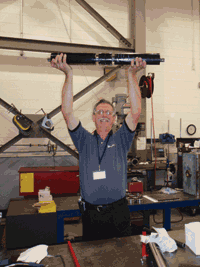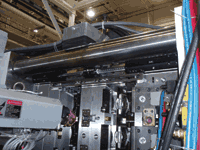New Product: Simplified stack mold centering
Based on customer feedback, D-M-E re-engineered assemblies for its new Helical Gear Centering Devices for stack molds in strong but lightweight Aircraft-grade aluminum, easing installation.
April 1, 2007
Based on customer feedback, D-M-E re-engineered assemblies for its new Helical Gear Centering Devices for stack molds in strong but lightweight Aircraft-grade aluminum, easing installation. D-M-E's new stack mold centering device assemblies are built from standard, field-proven components. Compact, lightweight, easily adjustable, and strong, D-M-E's HG centering devices do not obstruct robotic parts removal. |
Available from stock, a low-maintenance, standardized helical-gear centering device for stacks helps you dodge design and manufacturing hassles and beat the lead time clock.
Engineered to simplify the design, production, and maintenance of stack molds—and to help you help your customers speed their products to market—a standardized helical gear (HG) centering device is now available from stock from D-M-E. Designed to ensure that a stack mold's parting lines open at the same time and space, shot after shot, D-M-E's Frank Eigler, senior liaison engineer, and Chuck Azzopardi, product manager of mold components, say their lightweight, compact HG systems offer several advantages over many types of rack-and-gear and harmonic arm centering devices, not the least of which are easier adjustability and zero robot interference.
Built from components originally developed a few years back by D-M-E's Germany-based operation, the company can supply complete, off-the-shelf systems, or, off the same shelf, field-proven system components, which include the following:
A nylon insert nut
Double-sided HG shafts-with lengths must cut to size
Blank nut housings-lengths cut to size; mounting holes machined
Nut housing cap
Bearing housing
Taper roller bearing
“D-M-E Normalien marketed these components in Europe for decades. Mainly they were used in unscrewing molds. We saw in them perfect pieces to put together to eliminate extraneous work on the part of our stack mold customers, so they could concentrate more on the molds themselves,” Eigler says.
Off-the-Shelf Productivity
Azzopardi gives all the credit to the development of the HG centering device to his colleague, Eigler.
“The main components, like the shaft and the gear shaft nuts, have been used for decades. Anyone who built stack molds could buy them off the shelf, but they had to design and assemble all the other components.
“Frank worked around stack tools for decades at Tradesco, now StackTeck, before joining D-M-E a decade ago. He has the design expertise and he talked to stack moldbuilders to get their input on how best to put these well-known design elements together-all off-the-shelf-components-and to make a line of standardized products that make moldmakers' lives a whole lot easier. It's as easy as buying ejector pins.”
The HG centering device is strong, but it's lightweight. It's also designed to be robust. However, humidity, temperature, and contamination can adversely affect the performance of the nylon nut. Regular greasing can increase their service lives, though the nuts are designed to work in clean environments without external lubrication. You should keep your PM eye on them, though.
“Nylon is weaker than steel and aluminum, but if it breaks, it can easily be replaced, so nothing is lost,” Eigler says. “It's like a built-in safety.” The taper rolling bearings do have to be regularly greased, but Eigler and Azzopardi say no other maintenance is required.
Both recommend that the HG nut housing should be mounted on the plate or ejector box closest to the platen. Otherwise, the mold's internal screws holding the plates together would be subjected to periodic compression and stress. Space consideration may determine mounting locations.
Special, extra-long helical gears can be provided that are longer than a mold's total shut height, and clearance holes can be drilled into the stationary and moving platens of a molding machine, if there are shut height and platen size limitations on the press.
An Easy Entry
In addition to its brochures and manuals, D-M-E also can provide an informative DVD demonstrating the ease-of-installation, ease-of-alignment, and operational capabilities of its HG Centering Systems. Currently, sizes with gear shaft ODs of 28 mm (1000- and 1200-mm-long sizes) and 38 mm (1500 mm long) are available off the shelf. However, at one customer's request, a unit with a 48-mm spline (2000 mm long) was produced. It reportedly will be made available to the marketplace soon.
Eigler says D-M-E can work with you to package the proper components to accommodate your specific shut height and parting line opening requirements. Azzopardi emphasizes the fact that the systems are built from off-the-shelf components. “The moldbuilder doesn't have to spend time reinventing the wheel,” he says.
“We can design the centering systems in-house, if the customer is new to stack molds. We even have similar concept designs we'll be fine-tuning over the next year or two for rack-and-pinion centering devices. We believe in letting our customers chose what works best in their application.”
Both agree that they see an increased interest in anything that raises mold productivity without substantially raising costs.
“A lot of people are looking to improve their productivity gains. We feel our HG centering device is an easy entry way for those unfamiliar with stack molding to gain in the productivity benefits it can provide,” says Eigler.
About the Author(s)
You May Also Like





